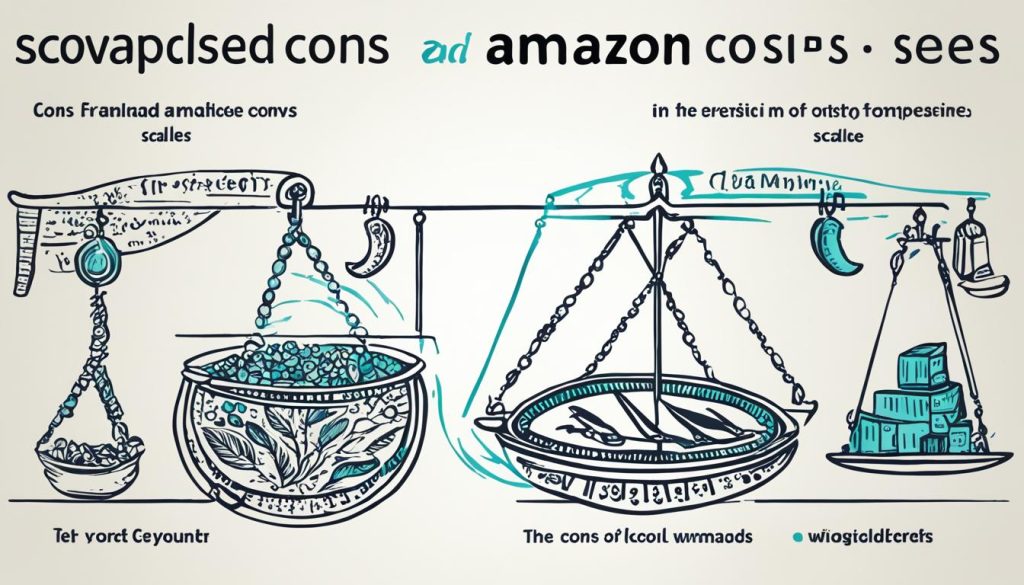Are you an artist looking to expand your reach and sell your artwork to a wider audience? Amazon Handmade is the perfect platform for you! With its massive customer base and global presence, Amazon Handmade provides a great opportunity for artists to showcase and sell their handmade products, including paintings, on a trusted and reputable platform.
Selling artwork on Amazon Handmade is not only convenient but also profitable. With no listing fees and a 15% fee per sale, artists can keep more of their earnings while reaching millions of potential customers. Whether you specialize in abstract art, pottery, or any other form of artwork, Amazon Handmade provides a dedicated marketplace for your unique creations.
By joining Amazon Handmade, you can create a customized shop profile that tells your story and showcases your artwork in a visually appealing way. This personalized touch helps you connect with customers on a deeper level and differentiate yourself from other sellers. With the option to use Amazon’s fulfillment services, you can also streamline your shipping and delivery process, providing a seamless experience for your customers.
However, it’s important to consider both the pros and cons of selling artwork on Amazon Handmade. While the platform offers a massive customer base and convenience, there may be limitations in terms of product categories and user-friendliness. By understanding these factors and implementing effective strategies, you can maximize your success on Amazon Handmade and grow your art business.
Key Takeaways:
- Selling artwork on Amazon Handmade allows you to tap into a massive customer base and reach potential customers around the world
- Amazon Handmade provides a dedicated platform for artists to showcase and sell their handmade products, including paintings
- Creating a customized shop profile helps you connect with customers and differentiate yourself from other sellers
- Consider the pros and cons of selling on Amazon Handmade, such as limited product categories and user-friendliness, and implement effective strategies to maximize your success
- By joining Amazon Handmade, you can streamline your shipping and delivery process using Amazon’s fulfillment services
What is Amazon Handmade?
Amazon Handmade is a specialized marketplace within Amazon where artists and crafters can sell their handmade products directly to customers. Launched in 2015, Amazon Handmade focuses exclusively on handmade, hand-altered, or hand-assembled items. It provides a platform for artisans to showcase their craftsmanship and connect with a global audience of art lovers.
One of the key features of Amazon Handmade is its artisan-only community. It creates a unique space for sellers to promote their handmade products and engage with customers who appreciate the artistry and creativity behind each piece. To ensure the authenticity and quality of the items, Amazon Handmade requires that all products sold on the platform be handmade.
Sellers on Amazon Handmade have the opportunity to create their own branded storefronts and share the story behind their creations. This personal touch allows them to establish a deeper connection with customers and build a loyal following. The platform also offers a dedicated category for handmade products, separate from other products listed on Amazon, which gives sellers more exclusivity and provides customers with a distinct consumer experience.
Amazon Handmade provides a platform for artisans to showcase their craftsmanship and connect with a global audience of art lovers.
How Amazon Handmade Works
Selling on Amazon Handmade is a straightforward process for artists and crafters looking to showcase their handmade products. To get started, sellers must fill out an application form and demonstrate their qualification as Handmade sellers by answering questions about their business. Once approved, sellers have the choice of two fulfillment options.
-
Fulfillment by Amazon (FBA):
Sellers who opt for FBA ship their products to an Amazon warehouse, where Amazon takes care of packaging and shipping. This method offers several advantages, including Amazon Prime eligibility and streamlined fulfillment. By leveraging Amazon’s fulfillment network, sellers can provide fast and reliable shipping to customers.
-
Fulfilled by Merchant (FBM):
Sellers who choose FBM handle the entire fulfillment process themselves. This includes packaging, labeling, and shipping the products directly to customers. FBM gives sellers more control over the shipping process and allows for flexibility in terms of packaging and branding.
Whether sellers prefer the convenience of FBA or the control of FBM, they can select the option that best aligns with their business needs and preferences.

Pros and Cons of Amazon Handmade
Selling artwork on Amazon Handmade offers numerous advantages. Firstly, Amazon’s massive reach, with 3.1 billion monthly visits and a high percentage of U.S. consumers shopping on the platform, provides artists with a vast potential customer base. This means that sellers have the opportunity to reach a wide audience and increase their chances of making sales.
The profitability of selling on Amazon Handmade is also worth considering. According to reports, 33% of Handmade sellers have profit margins above 20%, indicating the potential for significant financial success. Additionally, the platform is affordable for artists, with no listing fees and only a 15% fee per sale, allowing sellers to maximize their earnings.
One of the unique aspects of Amazon Handmade is its exclusivity as an artisan-only community. This creates a sense of authenticity and quality, allowing sellers to showcase their handmade products in a community of like-minded artisans. It also enables them to create a more personalized and memorable customer experience, which can help differentiate their business in the marketplace.
Amazon Handmade offers customizable shop profiles and artisan profiles, allowing artists to highlight their products and share their story with customers. This level of customization adds a personal touch to the selling process and helps create a stronger connection between sellers and buyers.
Fulfillment is made easy on Amazon Handmade through the option to use Amazon’s FBA or FBM services. Sellers can choose the method that best suits their needs and preferences, whether they prefer Amazon handling aspect of the fulfillment process or want more control over shipping and handling themselves.
“Selling artwork on Amazon Handmade can be a profitable opportunity for artists looking to reach a vast market. The platform’s affordability, artisan-only community, and customizable features provide numerous advantages.”
While there are many benefits to selling on Amazon Handmade, it’s important to consider some potential downsides as well. The user interface of Amazon Seller Central, particularly the dashboard, may be overwhelming or confusing for new sellers who are unfamiliar with the platform’s interface.
Additionally, the application process for Amazon Handmade can take up to two weeks, which may require some patience from artists eager to start selling their products. Furthermore, sellers on Amazon Handmade are not granted access to customer data, limiting their ability to build an email list or engage directly with customers outside of the platform.
Lastly, it’s worth noting that Amazon Handmade has limited product categories compared to the broader Amazon marketplace. While this exclusivity can be an advantage for some sellers, those who offer products outside of the available categories may need to consider alternative platforms to reach their target audience.

In summary, selling artwork on Amazon Handmade comes with its share of pros and cons. The platform offers artists access to a massive customer base, profitability, and the exclusivity of an artisan-only community. Additionally, its customizable features and fulfillment options make it convenient for sellers. However, the user-unfriendly dashboard, lengthy application process, limited access to customer data, and restricted product categories should be taken into account by those considering selling on Amazon Handmade. By carefully weighing these factors, artists can make an informed decision and determine whether Amazon Handmade is the right platform for their artistic business.
Amazon Handmade vs. Etsy
When it comes to selling handmade products, two popular platforms that artists and crafters often consider are Amazon Handmade and Etsy. Both platforms have their own unique advantages and disadvantages, and sellers have the option to sell on multiple platforms to expand their reach and increase sales.
Amazon Handmade offers a massive customer base and the benefits of being integrated into the larger Amazon ecosystem. With 3.1 billion monthly visits, Amazon provides a broader reach and exposure to millions of customers. This can be especially advantageous for sellers looking to tap into a wide range of potential buyers. Additionally, selling on Amazon Handmade allows artists to take advantage of Amazon’s robust fulfillment services, such as Fulfillment by Amazon (FBA), which streamlines the shipping and customer service processes.
Etsy, on the other hand, is known for its focus on handmade, vintage, and unique products. It offers a niche community of buyers specifically interested in one-of-a-kind items. The platform has a user-friendly interface and allows sellers to create custom storefronts to showcase their brand and artistic vision. Etsy also provides various marketing tools to help sellers promote their handmade products and attract potential customers.
When it comes to fees, Amazon Handmade charges a 15% fee per sale, while Etsy has listing fees and transaction fees. The fee structure is an important factor to consider when deciding which platform aligns better with an artist’s business goals and profit margins.
“Selling on both platforms can offer the best of both worlds and reach a wider range of customers.”
Ultimately, the choice between Amazon Handmade and Etsy depends on various factors such as the target audience, the type of handmade products being sold, and the overall business goals of the artist. Some sellers may find success by selling on both platforms, leveraging the advantages of each to reach a wider range of customers and increase sales.
How to Get Started with Amazon Handmade
Are you an artist or crafter looking to sell your handmade creations on Amazon Handmade? Getting started is a simple process that involves applying and going through a thorough review process. Let me guide you through the steps to kickstart your journey on this artisan marketplace.
1. Application Process
To begin selling on Amazon Handmade, you’ll need to fill out an application form. This form will require information about your business, including details about your craft and the production process. It’s important to showcase that your products meet Amazon’s handmade criteria, which includes being completely handmade, hand-altered, or customized.
During the application process, you may also be asked to provide photos of your products. This is an opportunity to showcase the quality and uniqueness of your creations, so be sure to present them in the best light possible.
Once you’ve completed the application, it usually takes up to 2 weeks to receive approval. Amazon Handmade takes the time to review applications carefully to ensure the authenticity and craftsmanship of the products being sold.
2. Creating Your Listings
Once approved, it’s time to create your listings on Amazon Handmade. This involves adding product titles, descriptions, and images. It’s important to provide accurate and detailed information about your products to attract customers.
You can enhance your listings by highlighting the unique features and benefits of your handmade creations. Share the story behind your craft, inspiring potential buyers with your passion and artistic vision. Remember, customers appreciate the personal touch that comes with handmade products, so adding that personal touch to your listings can make a big difference.
A handmade creation is not just a product; it’s a piece of art that carries the artist’s soul.
When adding images, ensure they are high-quality and showcase your products from different angles. Images that represent the craftsmanship and attention to detail can help customers visualize the unique qualities of your creations.
3. Utilizing Amazon’s Marketing Tools
Amazon Handmade offers a variety of marketing tools to help you promote your products and increase visibility. One such tool is sponsored product ads, which can effectively boost your product’s reach within the Amazon marketplace.
Consider using sponsored product ads strategically to target specific keywords or categories that align with your product offerings. This can drive more traffic to your listings and potentially increase sales.
Remember to track and analyze the performance of your marketing campaigns regularly. This will help you optimize your strategies and maximize your return on investment.
Getting started with selling on Amazon Handmade requires a combination of creativity, effective marketing, and a commitment to delivering high-quality handmade products. By following these steps, you can begin your journey on Amazon Handmade and tap into a global audience of art enthusiasts.
Tips and Tricks for Selling Artwork on Amazon Handmade
To successfully sell artwork on Amazon Handmade, there are several tips and tricks that can help artists optimize their listings and attract customers.
One tip is to include creative and compelling descriptions for their products, highlighting the benefits and unique features of their artwork. Customers appreciate the story behind the creation, so sharing the inspiration and artistic process can make a listing more appealing.
“My art is inspired by the vibrant colors of nature, and I aim to capture its beauty in every brushstroke. Each painting tells a story, inviting viewers to immerse themselves in the serenity of the landscapes.”
Using relevant keywords in the product titles and descriptions is essential for better visibility in search results. Sellers can use tools like the AMZScout Keyword Search and the Helium 10 Chrome extension to find popular and relevant keywords for their niche.
Another tip is to take advantage of Amazon’s advertising options, such as sponsored product ads, to promote artwork and increase its visibility to potential customers. These ads can help target specific audiences and drive traffic to listings.
Sellers should also regularly analyze sales data and customer feedback to optimize their product offerings and pricing. Understanding what customers are looking for and incorporating their feedback can help improve sales and customer satisfaction.
Providing exceptional customer service and building a positive reputation are crucial for attracting and retaining customers. Promptly responding to inquiries, packaging artwork securely, and delivering orders on time can help build trust and loyalty.
I always go the extra mile to ensure my customers are happy. From carefully packaging each artwork to providing personalized thank-you notes, my goal is to exceed expectations and create a memorable buying experience.
By implementing these tips and tricks, artists can enhance their selling strategies on Amazon Handmade and promote their handmade products effectively. Remember, success on Amazon Handmade requires a combination of high-quality artwork, strategic marketing, and a dedication to customer satisfaction.
Conclusion
Selling artwork on Amazon Handmade can open up a world of opportunities for artists and crafters who want to showcase their creations to a wide audience. With access to Amazon’s massive customer base and the ability to create personalized shop profiles, sellers have the potential to achieve high sales volumes and profitability. However, it is crucial to consider the pros and cons of selling on Amazon Handmade and compare it with other platforms like Etsy to determine the best fit for individual business goals.
By following the tips and strategies outlined in this article, artists can optimize their listings, attract customers, and build a successful business on Amazon Handmade. They can leverage the platform’s features, such as customizable shop profiles and advertising options, to increase visibility and appeal to their target audience. By providing exceptional customer service and focusing on delivering high-quality handmade products, artists can establish a positive reputation and cultivate a loyal customer base.
Success on Amazon Handmade lies in dedication, creativity, and a commitment to delivering exceptional craftsmanship. Taking advantage of the immense potential of Amazon’s customer base while being mindful of the platform’s limitations can help artists turn their passion for art into a thriving online business. With the right mindset and a focus on continuous improvement, artists can navigate the ever-evolving landscape of selling artwork on Amazon Handmade and achieve their desired level of success.
FAQ
How can I sell artwork on Amazon Handmade?
What is Amazon Handmade?
How does Amazon Handmade work?
What are the pros and cons of selling on Amazon Handmade?
How does Amazon Handmade compare to Etsy?
How can I get started with Amazon Handmade?
What are some tips for selling artwork on Amazon Handmade?
Share this content:






